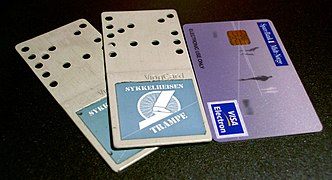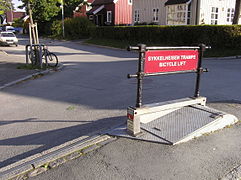Bicycle lift
The world's first bicycle lift has been in Trondheim , Norway , since 1993 . The first version, which was in operation until 2012, was replaced in 2013 by a more modern version that meets the safety regulations that have now become stricter in Norway. The lift called Sykkelheisen Trampe in Trondheim is 130 m long.
Under a slot near the sidewalk edge in a channel, the lift contains a circulating pull rope ( CycloCable system ) into which a footplate is latched, which is driven and pushed uphill with great force . The system works similarly to a permanently coupled cable tram . The start is only possible at the valley station, where a wedge-shaped structure on the roadway offers a small horizontal surface for setting up with the bike.
The user first stands with his bicycle to the left of this plate. Then he stands on this plate , leaning slightly forward, with his right leg stretched backwards as a standing leg . When the lift starts, you cycle up the street with your right foot on the footplate. In order to maintain balance, it is necessary to keep the track with the front wheel and a minimum distance (approx. 5 to 10 cm) to the right curb as evenly as possible. The most important thing is to put the load on the right leg, as only this is pushed, while the bike pulls back over the road gradient, increasing the load on the left leg. In order to compensate for this counter-pull, it is useful to form an arch forward with the upper body, as is usually the case with cycling, and to push the handlebars of the bike forwards with the arms, i.e. up the slope. Only the support of the body on a total of four points (legs and arms) results in a stable body position, which here must be maintained for a little more than a minute by means of muscle tension. You let your left foot rest on your pedal, which is a little behind the position of your bottom dead center. Loads on the bicycle cause a noticeable increase in the repulsive force; Loads that sit on the body - such as a backpack - can be placed on the leg to the right of the footplate.
The speed of the Skirail CycloCable is 7.4 km / h, i.e. around 2.05 m / s, which results in a travel time of 63 seconds over a distance of 130 m. The average gradient is 18%, which results in a 23 m difference in altitude over 130 m.
The climbing technique must be practiced. Long journeys with such a lift can be exhausting due to the one-sided, rigid load on the right foot.
The city of Winterthur in Switzerland also included two bicycle lifts in its 2012 traffic concept, and Zurich is reviewing their use. In the meantime, however, these plans have been postponed (for the last time in March 2019) by the municipality of Winterthur to a later date and subject to a positive test result.
Web links
- youtube video
- Trampe CycloCable. Til topps med sykkelheisen! Design Management AS, archived from the original on October 2, 2017 ; Retrieved March 28, 2018 (Norwegian, English).
- Sykkelheisen Trampe. In: trondheim.no . City of Trondheim , accessed March 28, 2018 (Norwegian).
Footnotes
- ↑ Sykkelheisen Trampe: Sykkel : Fahrrad, Heisen : Elevator, Trampe : "Trampeln", proper name of the elevator
- ↑ Skirail Cyclocable
- ↑ Tages-Anzeiger November 8, 2012, Velolifte also for Zurich
- ^ Resolution of the city council of March 10, 2019
Coordinates: 63 ° 25 ′ 40.8 ″ N , 10 ° 24 ′ 14.5 ″ E





